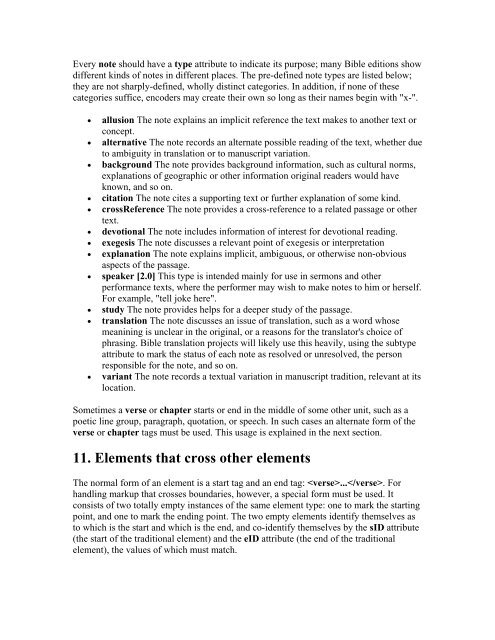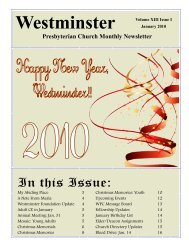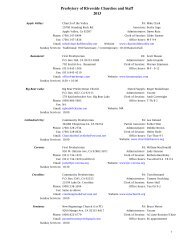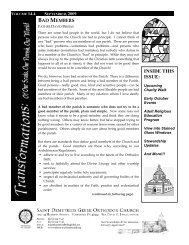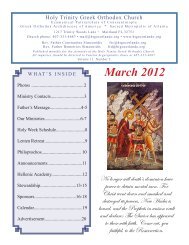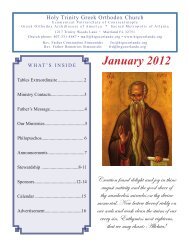OSIS? 2.0.1 User's Manual - Web services are running on AMBIB
OSIS? 2.0.1 User's Manual - Web services are running on AMBIB
OSIS? 2.0.1 User's Manual - Web services are running on AMBIB
You also want an ePaper? Increase the reach of your titles
YUMPU automatically turns print PDFs into web optimized ePapers that Google loves.
Every note should have a type attribute to indicate its purpose; many Bible editi<strong>on</strong>s show<br />
different kinds of notes in different places. The pre-defined note types <str<strong>on</strong>g>are</str<strong>on</strong>g> listed below;<br />
they <str<strong>on</strong>g>are</str<strong>on</strong>g> not sharply-defined, wholly distinct categories. In additi<strong>on</strong>, if n<strong>on</strong>e of these<br />
categories suffice, encoders may create their own so l<strong>on</strong>g as their names begin with "x-".<br />
• allusi<strong>on</strong> The note explains an implicit reference the text makes to another text or<br />
c<strong>on</strong>cept.<br />
• alternative The note records an alternate possible reading of the text, whether due<br />
to ambiguity in translati<strong>on</strong> or to manuscript variati<strong>on</strong>.<br />
• background The note provides background informati<strong>on</strong>, such as cultural norms,<br />
explanati<strong>on</strong>s of geographic or other informati<strong>on</strong> original readers would have<br />
known, and so <strong>on</strong>.<br />
• citati<strong>on</strong> The note cites a supporting text or further explanati<strong>on</strong> of some kind.<br />
• crossReference The note provides a cross-reference to a related passage or other<br />
text.<br />
• devoti<strong>on</strong>al The note includes informati<strong>on</strong> of interest for devoti<strong>on</strong>al reading.<br />
• exegesis The note discusses a relevant point of exegesis or interpretati<strong>on</strong><br />
• explanati<strong>on</strong> The note explains implicit, ambiguous, or otherwise n<strong>on</strong>-obvious<br />
aspects of the passage.<br />
• speaker [2.0] This type is intended mainly for use in serm<strong>on</strong>s and other<br />
performance texts, where the performer may wish to make notes to him or herself.<br />
For example, "tell joke here".<br />
• study The note provides helps for a deeper study of the passage.<br />
• translati<strong>on</strong> The note discusses an issue of translati<strong>on</strong>, such as a word whose<br />
meanining is unclear in the original, or a reas<strong>on</strong>s for the translator's choice of<br />
phrasing. Bible translati<strong>on</strong> projects will likely use this heavily, using the subtype<br />
attribute to mark the status of each note as resolved or unresolved, the pers<strong>on</strong><br />
resp<strong>on</strong>sible for the note, and so <strong>on</strong>.<br />
• variant The note records a textual variati<strong>on</strong> in manuscript traditi<strong>on</strong>, relevant at its<br />
locati<strong>on</strong>.<br />
Sometimes a verse or chapter starts or end in the middle of some other unit, such as a<br />
poetic line group, paragraph, quotati<strong>on</strong>, or speech. In such cases an alternate form of the<br />
verse or chapter tags must be used. This usage is explained in the next secti<strong>on</strong>.<br />
11. Elements that cross other elements<br />
The normal form of an element is a start tag and an end tag: .... For<br />
handling markup that crosses boundaries, however, a special form must be used. It<br />
c<strong>on</strong>sists of two totally empty instances of the same element type: <strong>on</strong>e to mark the starting<br />
point, and <strong>on</strong>e to mark the ending point. The two empty elements identify themselves as<br />
to which is the start and which is the end, and co-identify themselves by the sID attribute<br />
(the start of the traditi<strong>on</strong>al element) and the eID attribute (the end of the traditi<strong>on</strong>al<br />
element), the values of which must match.


